Seagate Barracuda XT 2TB: SATA 6Gb/s Performance Preview
by Gary Key on October 29, 2009 12:00 AM EST- Posted in
- Storage
AnandTech Small Folder Transfer Results –
In our first storage test, we utilize a 3.82GB test folder and transfer it from our WD VelociRaptor drive to the competing hard drives.

There is only a 2% difference in performance between the two drives on the Intel P55 controller and basically a tie on the Marvell controller. We did not expect anything really different as the average sustained transfer rates between all three drives are very close.
In our second storage test, we utilize the same 3.82GB test folder and transfer it from our test hard drives to the Intel 160GB SSD.
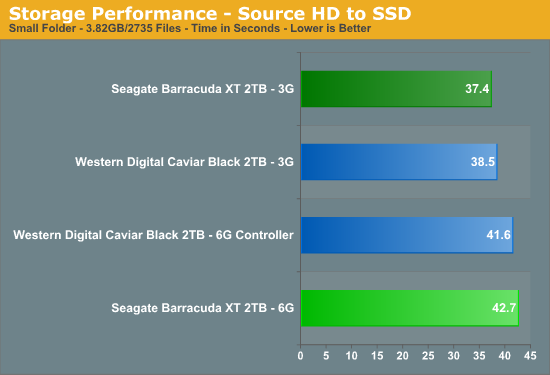
The tables flip here with the Seagate drive performing about 3% faster on the Intel controller than the WD drive. However, Seagate drive is 12% faster in this test on the Intel P55 in 3Gb/s mode than at 6Gb/s mode on the Marvell controller.
In our final small folder test, we utilize the 3.82GB test folder and transfer it from our test SSD back to the competing hard drives.

We finally see the Marvell 9128 chipset making a difference. The Seagate XT drive is 9% faster in 6Gb/s operation than in 3Gb/s mode on the Intel P55. We noticed peak transfer rates of 296MB/s on the Marvell controller compared to 262MB/s on the Intel controller with the Seagate drive. In both cases, the Seagate drive is faster in this test than the Western Digital drive.
AnandTech Large Folder Transfer Results –
In our first storage test, we utilize a 15.2GB test folder and transfer it from our WD VelociRaptor drive to the competing hard drives.
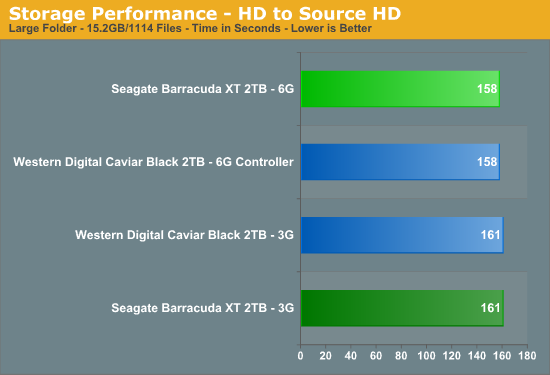
Our two drives perform identically on like controllers, the only difference here is that the Marvell controller is leading Intel in part to the aggressive 1027 driver algorithms that utilize additional system memory for transfer caching.
In our second storage test, we utilize the same 15.2GB test folder and transfer it from our test hard drives to the Intel 160GB SSD.
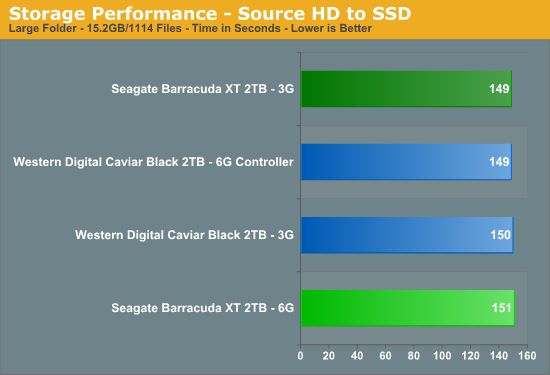
Interestingly enough, the WD drive is faster on the Marvell controller than the Intel. However, the Seagate drive benefits from the Intel controller.
In our final large folder transfer test, we utilize the 15.2GB folder and transfer it from our test SSD back to the competing hard drives.
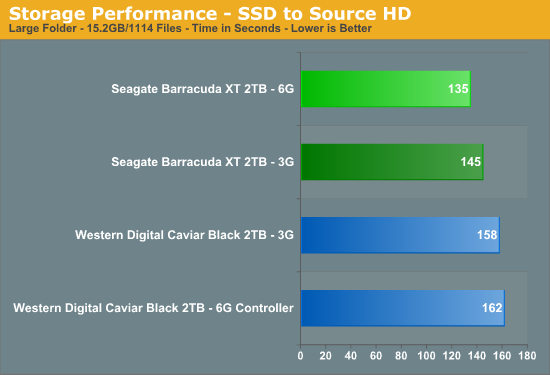
Like our small folder test, we see the benefits of the Marvell Controller in SATA 6Gb/s mode as the Seagate drive is 7% faster than it is in SATA 3Gb/s operation. The WD drive is up to 17% slower in this particular test.
PCMark Vantage x64 Results –
We are showing the total score for the PCMark Vantage disk benchmark as a reference point between the two controllers and drives.
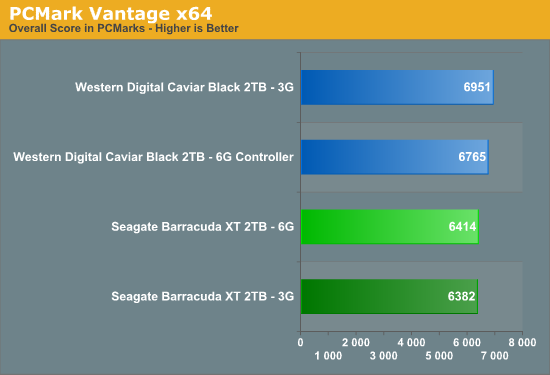
The Seagate XT drive in SATA 6Gb/s mode on the Marvell controller is barely faster than SATA 3Gb/s mode on the Intel controller. The WD drive is just flat out faster in this particular benchmark with the Intel controller being about 3% faster than the Marvell controller.
Quick Thoughts:
That was a letdown in several ways. We never really expected that much out of SATA 6Gb/s technology as our two hard drive samples are just now pushing the boundaries of SATA 1.5Gb/s. Only when we utilized a fast SSD as the source drive to copy files to the Seagate Barracuda XT did we see an advantage in the burst rates available on it and the Marvell 9123 chipset. Even then, the advantage was fleeting as the sustained transfer rates equalized quickly between the two controllers. This test is just the opposite of what a typical user would perform anyway as most would utilize the hard drive for storage purposes and not the SSD.
Even more disturbing was the performance disparity between the Seagate Barracuda XT 2TB and the Western Digital Caviar Black 2TB drive in our limited benchmark test suite. We expected more from the Seagate drive based on its specifications, not the 6Gb/s abilities but platter design and cache setups. Hopefully Seagate can improve performance with firmware changes, if not; the battle is already lost regardless of controller technology.
We just do not see SATA 6Gb/s technology offering any real benefits for spindle-based hard drives on the desktop at this time. Rotational speeds are being kept in check at 7,200rpm with all the performance improvements coming from increased areal densities and cache. We expect SATA 6Gb/s to really come into its own with solid state drives. This will not occur quickly but we expect to see recognizable benefits with controller designs about two generations ahead of where we are currently. By that time, both AMD and Intel will have native 6Gb/s capabilities on their controller hubs.
In the meantime, we see the current implementations of 6Gb/s technology on motherboards as being a marketing checklist feature for the most part. However, since the Marvell 9123 chipset can fall back to SATA 3Gb/s or 1.5Gb/s operational mode it does offer additional SATA ports on the motherboard with performance that is fine for secondary storage devices.










55 Comments
View All Comments
Transisto - Thursday, October 29, 2009 - link
Port multiplier technology are often used for external raid unit over a single Esata.That would be a good use,
As for the article,,,,,,, did someone at Anand really though a "nothing special" HDD would saturate 3Gb/s ? I wonder if even 5% of readers though so.
Captainbob001 - Thursday, October 29, 2009 - link
I agree with the other writers on here, no need for sata 6gb/s. I believe we are at the mechanical limit with 3 gb/s sata with spinning platters. I believe we will see differences when SSD starts utilizing it. Right now drives in raid0 configuration get much better mb/s times than these tests.Concillian - Friday, October 30, 2009 - link
We aren't necessarily at any limit, just that controller throughput is always well ahead of hard drive throughput. This has been the case since we had hard drive controllers installed in the ISA bus. It's always some great new throughput of the controller that the hard drives can't take advantage of yet.It's still a good thing though, because you don't want to be in the case where you have a traffic jam on your 2 lane highway 100% of the time before you add a new lane. If that were the case all the drives now would be on PATA/100. It's much better when the controller leaps are not very exciting. The manufacturers are doing their job if controller throughput leaps aren't exciting.
zephyrprime - Thursday, October 29, 2009 - link
Pcie 1.0 was 250mb/s for each lane but isn't pcie 2.0 500mb/s for each lane? I would think a p55 board would have pcie 2.0, right?
kureshii - Thursday, October 29, 2009 - link
IIRC the P55's PCIe lanes are 2.0-specced, but bandwidth-limited to PCIe 1.1 speeds to prevent choking up the DMI bus.chizow - Thursday, October 29, 2009 - link
That's also correct from what I've read, the P55 is PCIE 2.0 but the ICH10R is only PCIE 1.1. It could very well be an attempt to prevent choking up the DMI bus, but knowing Intel, I wouldn't doubt it if the decision was made so X58 and P55 wouldn't feature-compete with each other or offer a competitive advantage to outside solutions before they rolled out their own native SATA 6.0 and USB 3.0 solution. That's really why we're seeing all these workarounds to begin with, because Intel has been dragging their feet on adopting and implementing these specs.JarredWalton - Thursday, October 29, 2009 - link
The catch is that PCI-E 1.x is 250MB/s aggregate bandwidth, but half of that is upstream and half is downstream. So the 500MB/s figure for two PCI-E 2.0 lanes is correct in that the maximum rate to or from the drive would be 500MB/s.Griswold - Thursday, October 29, 2009 - link
Get a port multiplier and hook up 4 of them per channel - watch the bandwith put to good use, if you actually need it.Now do the same with all the other ports and you got a, for a desktop system, ridiculous amount of storage capacity with all disks capable of operating at their best sequential read/write performance.
:P
yyrkoon - Thursday, October 29, 2009 - link
A good SAS controller would trump port multipliers using 2 channels cascaded.Griswold - Thursday, October 29, 2009 - link
Yea, just that nobody is talking about SAS in this context...